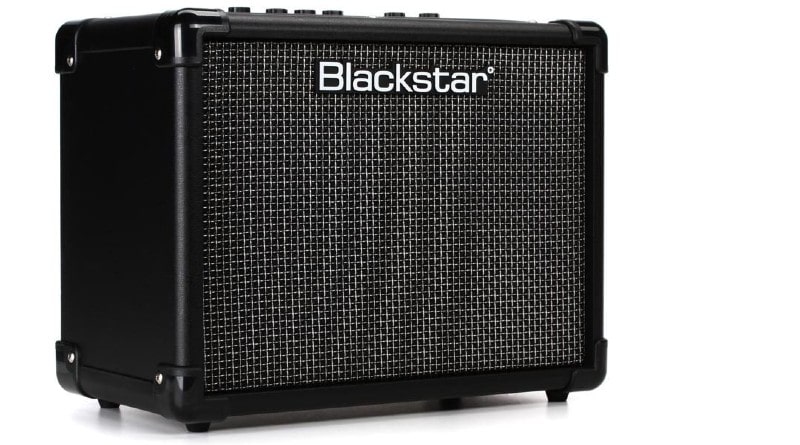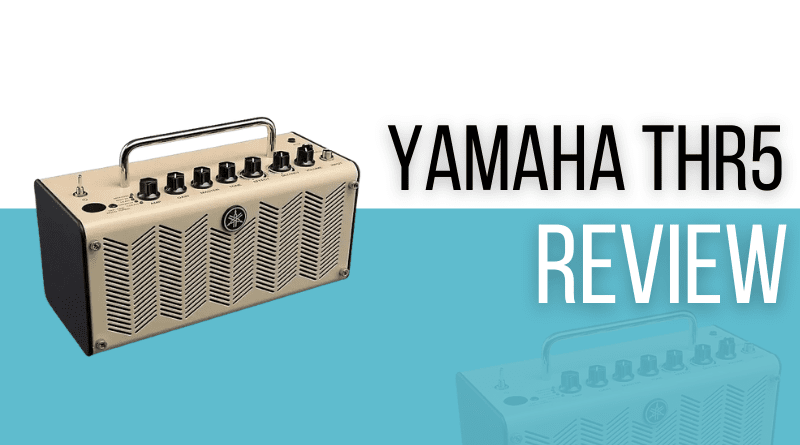Until fairly recently, desktop and micro amps were simply not competitive with more traditional combo practice amps. Their speakers were small and tinny, there weren’t any on board FX to speak of, and ultimately, they were little more than novelties and stocking stuffers.
The desktop amps of today are determined to shake off the old image, however.
One of the models at the vanguard of this revolution is the small, but mighty Yamaha THR5, the smallest model in Yamaha’s desktop modeling amp lineup. It’s developed quite a reputation for quality in online circles, but does it live up to the hype? Keep reading as we find out.
Read more about our review process.
Contents
Yamaha THR5: Who Is this For?
The Yamaha THR5 is suitable for players of all levels. It makes a great first amp when you’re just getting started, and for more advanced players it’s a great quality, highly portable desktop amp that works great for bedroom practice, or even noodling on the tour bus. On top of all that, if you’re planning to experiment with recording, it also functions as an interface!
Yamaha THR5: Appearance / Features / Controls
We’ve tested a lot of amps over the years at KGR, and we’re yet to find one that is as cool as the Yamaha THR5.
It’s a 5w solid state modeler that wants you to think it’s a tube amp, even down to the orange light behind the grille that gradually gets brighter after you turn it on, replicating the soft glow of saturated tubes. As a feature it’s completely unnecessary, but we loved it anyway!
As briefly mentioned in the above section, the THR5 can be used as an interface for recording in your preferred DAW via the USB connection.
As for the amplifier voicings, there are a total of 5:
- Clean
- Crunch
- Lead
- Brit Hi
- Modern
As well as the amp voicings, there are also a selection of built in FX, including chorus, flanger, phaser, and tremolo. Chorus thickens the sound by multiplying the input signal and slightly changing pitch, timbre and timing to give the impression that multiple guitars are playing simultaneously. Flanger works similarly to chorus but increases the delay factor, giving a whooshing quality to the sound. The phaser effect recreates the unique sound of a rotating speaker, adding a distinctive swirly texture. The last effect, tremolo, acts in the same way as a tremolo arm or whammy bar, modulating the pitch, which again adds a distinctive texture.
To add some extra variety to the FX, you can choose from 4 different delay and 4 reverb effects. There’s a delay setting, which simply repeats the input signal and decays according to the settings. A delay/reverb setting, which blends the plain delay with room reverb to make the sound more atmospheric. There’s a spring reverb effect, which mimics the spring reverb found in vintage tube amps like the 65’ Fender Princeton Reverb, and there’s a hall reverb, which has a cavernous echo effect.
Yamaha THR5: Performance/Sound
We started this test by checking the clean channel without any FX or reverb activated. It offered excellent clarity, and that clarity remained consistent from the lowest volume setting until it was maxed out (if you need more volume, check out the 10w THR10 and the 30w THR30). When we added some effects, we found that the clean channel handled the built in selection very well, and we were even impressed by the stereo effect that the twin speakers were able to create with the modulation effects.
The crunch voicing was our favorite of all the amp settings, particularly with chorus and reverb/delay running simultaneously. It really delivered some quality, tube like tones, even at super low volume, which is something that even genuine tube amps can’t manage! Given that the most likely use cases for this amp are bedroom level practice and light duty recording work, this alone justifies the purchase in our minds.
The lead setting was a little bland for our tastes. It landed somewhere between clean and crunch, so it didn’t give us any real clarity, nor did it give us enough break up to make it tonally interesting. Brit Hi was a fun setting to play with, especially as you don’t typically expect that much growl to come from such a small amp! We also enjoyed experimenting with the modern voicing, which when paired with the phaser effect and hall reverb gave us some ethereal “Bill and Ted” style tones.
One notably missing feature was any kind of on board EQ (outside of the app). We would like to have seen at least bass and treble dials to shape the sound a bit more.
Of course, the built in effects and amp voicings aren’t the be all and end all. Being a modeling amp, you can use the Yamaha THR Editor companion app to modify the settings of the presets and even download new plugins. The software was easy to use and had a fantastic graphic interface that felt a lot like using a real amp.
While the sound quality was great, the overall depth of sound is the biggest weak point of the THR5. The small speakers can’t fill a room in the same way that even a single 8” or larger speaker can. Ultimately, this makes the THR5 unsuitable for gigs or public performance of any type.
Other Desktop Amps to Consider
The Yamaha THR5 is a wonderful amp, but there are definitely other viable options if you’re looking for a top quality portable amp, take a look at these alternative suggestions:
Boss Katana Mini

This is a tiny 7 watt desktop amp that catches almost everybody off guard with its rich sound and excellent feature array. It has 3 amp voicings, full EQ control, adjustable delay, and separate gain/volume dials. There’s no way to edit amp voicings with the Katana Mini, which is an obvious downside, but it’s half the price of the Yamaha, and takes pedals well.
Blackstar ID:Core 10 V3

Like the Yamaha, the Blackstar ID:Core 10 V3 offers twin 3” speakers, 10 watts of power, multiple amp voicings and on board FX. It looks a bit more plain than the Yamaha, but Blackstar’s primary concern is substance over style. It has some of the best stereo sound you’ll ever hear in a small amp, and as a recording interface it’s simply fantastic.
Final Thoughts on the Yamaha THR5
The Yamaha THR5 is arguably one of the best practice amps on the market, including more traditional combos – hence it’s inclusion in so many of our roundups, such as best beginner amps, best solid state amps, best modeling amps, best amps under $500 and $300, best battery powered amps and more – this thing does a lot!
The sound quality is superb, the controls are simple and intuitive, and the amp voicings and FX are all very organic sounding. As we pointed out, it’s not a giggable amp, but that was never what this (and other amps like it) were ever designed for. If you’re looking for something that looks great on an office desk, is lightweight and portable, and doesn’t sacrifice tone despite the size, then you owe it to yourself to check out the Yamaha THR5.


